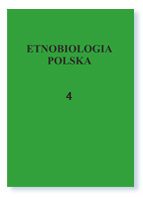Liście używane do zawijania gołąbków przez Ukraińców w rumuńskim Maramuresz: notatka etnobotaniczna
Słowa kluczowe:
sarmale, gołąbki, leaves used to wrap food, vine leaves, Japanese knotweed, Reynoutria japonica, Fallopia japonicaAbstrakt
This article is a contribution to knowledge of the leaves used to wrap sarma rolls in several villages inhabited by Ukrainians in northern Romania. We interviewed 28 inhabitants of the villages Lunca la Tisa, Remeți, Bistra, Poienile de sub Munte, Valea Vişelui and Repedea. Most people use cabbage (Brassica oleracea) and grape (Vitis sp.) leaves to wrap sarma. The leaves of the white beet (a variety of Beta vulgaris) are also often used. More rarely horseradish (Armoracia rusticana), red beetroot (a variety of Beta vulgaris) and Japanese knotweed (Reynoutria japonica) leaves are used. The use of the last species is of special interest as this is an alien invasive plant rarely used in Europe and its culinary use in the village of Remeți is be a local innovation.
Downloads
Bibliografia
Butură V 1979. Enciclopedie de etnobotanică românescă. Editura Ştiinţificăşi Enciclopedică, Bukareszt
Cvitanic M 2011. Culture and customs of Croatia. Greenwood Publishing Group, Santa Barbara (California, USA)
Dorigo W, Lucieer A, Podobnikar T, Čarni A 2012. Mapping invasive Fallopia japonica by combine spectral, spatial, and temporal analysis of digital orthophotos. International Journal of Applied Earth Observation and Geoinformation 19: 185-195
Gerber E, Krebs C, Murrell C, Moretti M, Rocklin R, Schaffner U 2008. Exotic invasive knotweeds Fallopia negatively affect native plant and invertebrate assemblages in European riparian habitats. Biological Conservation 141 (3): 646-654
Horváth I, Scacco A. ( 2008) The Culture of Migration on Rural Romanian Youth, "Journal of Ethnic and Migration Studies", Vol. 34, No. 5, July, 771-786.
Kavas A, Karakaya S 1997. A research note. Nutrient composition of stuffed vine leaves: a mediterranean dietary. Journal of Food Quality 20: 337-341
Khokhar S, Gilbert PA, Moyle CWA, Carnovale E ... & Bellemans M 2009. Harmonised procedures for producing new data on the nutritional composition of ethnic foods. Food Chemistry 113 (3): 816-824
Kołodziejska-Degórska I 2008. Z czego „uwarić harbatę”? Dzikie rośliny jadane w polskich wsiach na południowej Bukowinie (Rumunia). In: Łuczaj Ł (ed) Materiały z konferencji „Dzikie rośliny jadalne — zapomniany potencjał przyrody. Przemyśl-Bolestraszyce 13 września 2007 r. Arboretum i Zakład Fizjografi i w Bolestraszycach, Bolestraszyce, pp. 219-226
Kosiek T 2010. Czy w rumuńskim Maramureszu mieszkają Huculi? Kilka uwag o kategorii Hucuł i Huculszczyzna w kontekście marmaroskim, J. Stęszewski, J. Cząstka-Kłapyta (red.), Kultura współczesnej Huculszczyzny, Kraków: Oficyna Wydawnicza „Wichry”, s. 45-62.
Łuczaj Ł 2008a. Dzikie rośliny jadalne używane w okresach niedoboru żywności we wschodniej części Karpat (powiaty Krosno, Sanok, Lesko, Nadwórna, Kosów i Kołomyja) według ankiety szkolnej z 1934 roku. In: Ł. Łuczaj (ed), Dzikie rośliny jadalne – zapomniany potencjał przyrody. – Arboretum i Zakład Fizjografii w Bolestraszycach, Bolestraszyce, pp. 161-181
Łuczaj Ł 2008b. Dziko rosnące rośliny jadalne w ankiecie Józefa Rostafińskiego z roku 1883. Wiadomości Botaniczne 52(1/2): 39-50
Marciszewska M 1878. Kucharka szlachecka: podarek dla młodych gospodyń, zawierajęcy około 5,000 przepisów kuchennych, śpiżarnianych, domowo-gospodarskich i toaletowych. W Druk. Uniwersytetu Św. Włodzimierza (J. Zawadzkiego), Kijów
Marletta L, Camilli E, Turrini A, Scardella P, Spada R, Piombo L, Khokhar S, Finglas P & Carnovale E 2010. The nutritional composition of selected ethnic foods consumed In Italy. Nutrition Bulletin 35: 350-356
Muica N, Turnock D 2000. Maramures: Expanding human resources in the Romanian periphery. GeoJurnal 50: 181-198
Mulasmaic N 2011. Bosnian-English Dictionary: Turcisms, Colloquialisms, Islamic Words and Expressions. Authorhouse, Bloomington (IN, USA)
Ochorowicz-Monatowa M 1910. Polish Cookery: Uniwersalna Ksiazka Kucharska. Wydanie znacznie powiększone. Nakł. B Polonieckiego.
Pirożnikow E 2012. Rdestowiec ostrokończysty (Reynoutria japonica Houtt.) – roślina użytkowana kulinarnie w Puszczy Białowieskiej. Etnobiologia Polska 2: 27-32
Rizzuti A, Caliandro R, Gallo V, Mastrorilli P, Chita G, Latronico M 2013. A combined approach for characterisation of fresh and brined vine leaves by X-ray powder diffraction, NMR spectroscopy and direct infusion high resolution mass spectrometry. Food chemistry, 141(3): 1908-1915
Roman RA 2001. Bucate, vinurișiobiceiuriromânești. Paideia, Bucureşti
Szymanderska H 2003. Encyklopedia polskiej sztuki kulinarnej. Rea, Gliwice
Szymanderska H 2004. Kuchnia polska. Potrawy regionalne. Świat Książki, Warszawa
Vizirenau C, Burluc RM, Dabara A, Istrati D 2009. Research of the use of fagopyrum sp. for culinary preparations. Seria Agronomie 52(2): 109-116
Wielocha A 2002. Mapa Huculszczyzny. Płaj - Almanach Karpacki 25: 7-24
Куреляк В 1998. Гуцули Мараморощини і етногеографічні проблеми, Вісн.Львів. Ун-ту. Сер. геогр., 22: 41-48
Куреляк В 2001. Українці румунської Мараморощини. Видавничий центр ЛНУ ім. Івана Франка, Lviv
Леньо П 2010. Етнокультурні просеси в середовищі українців Мараморощини. Народна творчіст та етнографія 3: 36-46
Панькевич І 1934. Говір сіл ріки Руської Марамороша в Румунії. Наукoвий Збірник товариства «Просвіта» в Ужгороді 10: 185-216
Pobrania
Opublikowane
Jak cytować
Numer
Dział
Licencja
Prawa autorskie (c) 2014 Etnobiologia Polska

Utwór dostępny jest na licencji Creative Commons Uznanie autorstwa – Użycie niekomercyjne – Bez utworów zależnych 4.0 Międzynarodowe.


